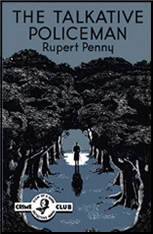Sun 25 Jul 2021
A Mystery Review by Doug Greene: RUPERT PENNY – The Talkative Policeman.
Posted by Steve under Reviews[5] Comments
RUPERT PENNY – The Talkative Policeman. Collins Crime Club, UK, hardcover, 1936. Ramble House, US, softcover, 2009.

Rupert Penny (pseudonym of Ernest Basil Charles Thornett) would have been astonished that his books are occasionally still read almost 50 years after they were published. In the foreword to The Talkative Policeman, Penny writes:
(My copy does not smell of bloater skins, but it does look like it has spent some time in dustbins.)
The Talkative Policeman is a puzzle story of the purest sort, unadulterated by characterization (Penny’s characters are indeed “lifeless flesh”), atmospheric setting, or felicitous writing style, Though there are two murders — one of a harmless clergyman, the other of an unknown — the corpses are bloodless, existing only to provide the problem for the detective.
When the detective’s friend, Tony Purdon, remarks that “one realized that Tatham was really alive once, and not always part of a puzzle,” Chief Inspector Beale responds, “Yes — I know that feeling, I usually try not to encourage it, if you understand.”
Penny’s adoption of a flat writing style seems to have been conscious , for when he wished he could introduce bits of humor and effective description. Purdon occasionally composes comic verses about the crime. After a suspect irrelevantly asks Sergeant Matthews for his opinion of the Sitwells, Matthews tells Beale, “Well sir, having no idea who the Sitwells might be, I wasn’t sure what’d be best, I said they’d do much better if they forgot they were the Sitwells.”
But such passages are rarities; Penny seems to have avoided them as mere distractions in a puzzle story.
Penny cites Ellery Queen as a model in writing a challenge-to-the-reader novel, and includes an “interlude” in which “the intelligent reader, if he has not already done so, should be able to attempt the solution of the problem with every prospect of success.”
To enjoy The Talkative Policeman, the reader must accept the book on its own terms: how good a puzzle is it? And on that standard it is a very good book indeed. The book has a map, transcriptions of questions and answers, and even characteristics of fingerprints. When these are not being compiled, Purdon and Beale consciously attempt to make deductions, sometimes also in the form of a list as “deductions (general)” and “deductions (particular)”.
Although once or twice their conclusions resemble those of Jack Ritchie’s Henry Turnbuckle, often they scintillate with intellectual excitement. I guessed the identity of the murderer, but I missed most of the clues (for which Penny calls me “a less intelligent reader”).
In short, The Talkative Policeman does exactly what Penny sets out to do; it challenges “players in the game” who are not “mere idlers, apathetic page-turners torpidly filling up the time.” The reader must pay attention.
In later books, Penny, while not mininalizing the puzzle, makes some concessions to readers interested in character and action as well as deductions. In Policeman’s Evidence, for example, the first half is told by Tony Purdon in the absence of Beale. The characters are revealed gradually; the humor is more evident; the murder occurs after the story has begun; and the problems — a cryptogram revealing a buried treasure and a locked-room murder — are compelling. After Beale arrives, however, the book is dominated by slow-moving question-and-answer. Oddly, in a TAD review Barzun and Taylor like the second half and find the first, more lively, section old-fashioned. But I’ve commented elsewhere on B & T’s aversion to the ingenious and bizarre.
The Insp. (Chief Insp.) Edward (Ted) Beale series —
The Talkative Policeman. Collins 1936.
Policeman in Armour. Collins 1937.
Policeman’s Holiday. Collins 1937.
The Lucky Policeman. Collins 1938.
Policeman’s Evidence. Collins 1938.
She Had to Have Gas. Collins 1939.
Sweet Poison. Collins 1940.
Sealed-Room Murder. Collins 1941.
July 25th, 2021 at 8:52 pm
I read on one of Penny’s books. It was more effort than I wanted to put into it sad to say.
July 25th, 2021 at 10:14 pm
The books are extremely hard to find, and until Ramble House finally reprinted them, their reputation perhaps exceeded their actual readability. I don’t know, as I have yet to read one, even though I own all but one of the eight, all in their original British editions. I don’t know what I’ve been waiting for!
July 26th, 2021 at 7:48 pm
The two Rupert Penny books I’ve read have some decent plotting and maps, especially “Policeman’s Holiday”. But they are rough sledding otherwise.
My web site calls the poorer of the two books, “Policeman’s Evidence” “one of the dreariest mysteries I have ever read.” As David said, you have to work and work to get through the darn thing.
July 26th, 2021 at 7:53 pm
This suggests a reason why the original books are so scarce (and why it too so long to get them published in US). No one bought them in the first place!
July 26th, 2021 at 8:09 pm
The relentless upper class snobbery of “Policeman’s Holiday†is also hard to take.
In fairness, one should add that mystery experts like Jon L. Breen and Martin Edwards admire Penny’s work.
Sooner or later, I should probably track down “The Talkative Policeman”.